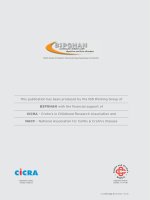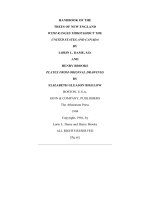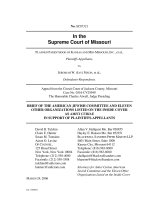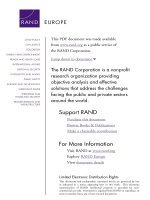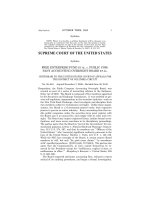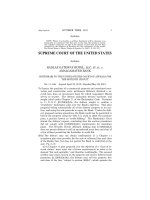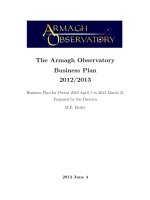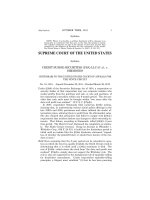THE SUPREME COURT OF THE UNITED KINGDOM: BUSINESS PLAN ppt
Bạn đang xem bản rút gọn của tài liệu. Xem và tải ngay bản đầy đủ của tài liệu tại đây (118.14 KB, 40 trang )
THE SUPREME COURT OF THE
UNITED KINGDOM
BUSINESS PLAN
1 April 2012 – 31 March 2013
Contents
Page Number
Introduction and Summary 3
Securing the Justices’ Constitutional 6
And Financial Independence
Promoting the Rule of Law 9
Providing Efficient and Effective 16
Administration
Maintaining Relationships with 25
All the UK Jurisdictions
Maintaining International Relationships 27
Delivering Corporate Responsibilities
30
2
Section 1
Introduction and Summary
3
Introduction
1. The Supreme Court of the United Kingdom (UKSC) was established by the
Constitutional Reform Act 2005 (CRA) and came into being on 1 October 2009. Its mission
and strategic objectives, which can be found in the next section, remain essentially the same
as those set out at its launch, although they have been slightly broadened to encompass,
where relevant, the work of the Judicial Committee of the Privy Council. This Business Plan
covers the UKSC’s third full financial year of operation and sets out our key aims and
objectives for that period and how we plan to achieve them. Our key Performance
Indicators (PIs) are set out in Annex A to this Business Plan.
The Judicial Committee of the Privy Council (JCPC)
2. From 1 April 2011 the UKSC took over from the Ministry of Justice (MOJ)
responsibility for the administration of the Judicial Committee of the Privy Council (JCPC),
which has been co-located with the UKSC since the UKSC’s inception in October 2009. A
key aim in 2012 – 2013 will be to continue the integration of the administration of the JCPC
with that of the UKSC, begun in 2011 - 12. More detail on this is set out in Section 7 below.
Managing within the Spending Review (SR) Settlement
3. This is the second of the four years covered by the settlement resulting from the
2010 Spending Review. This will be a period of declining resources for the UKSC. How the
Court more broadly envisages it will manage within its resources for the remainder of that
period is set out in the UKSC’s Strategic Plan for 2012 – 2015, but this Business Plan sets
out how it plans through greater efficiencies and otherwise to meet the key aim of living
within its declining means in the financial year 2012 – 2013.
Background and Context
4. The UKSC’s creation in 2009 marked the visible separation of the United Kingdom’s
highest court from both the executive and the legislature. It was designed both to increase
the transparency of the judicial process and to clarify the relationship between the Judiciary,
Government and Parliament. The role of the Court and the Justices is to act as the final
Court of Appeal for arguable points of law of general public importance arising from civil
cases throughout the United Kingdom; and from criminal cases in England, Wales and
Northern Ireland. The Court also hears cases to determine issues relating to the legal
competence of the devolved administrations, Parliaments and Assemblies. (This jurisdiction
transferred to the UKSC on 1 October 2009 from the JCPC.)
5. The UKSC is independent of the Ministry of Justice and of the separate Court
Services in England & Wales, Scotland and Northern Ireland. As an administration it is a
non-Ministerial department headed by a Chief Executive who is also the Accounting Officer.
The CRA sets out the statutory framework and defines the responsibilities of the Lord
Chancellor, the President of the Court and the Chief Executive. An ongoing task for the
4
Court is to ensure that the separate roles of the Judiciary, Executive and Legislature are clear
and widely publicly recognized.
Ongoing aims for 2012 – 2013
6. (i) We will maintain the constitutional position of the UKSC as the apex of the
judicial branch of the State and its independence from the Executive, in reality as well as in
theory. Since the Executive is a party in over half the cases which come before the court, it is
particularly important that this both is, and is seen to be, the case.
(ii) A key outcome will therefore be that the UKSC will continue to be publicly
recognized as unequivocally independent of political influence and interference; and it will
remain visibly separate from both the executive and the legislature and be publicly
acknowledged to be such.
(iii) It will also continue to be recognized as the single apex of the UK’s civil law and,
apart from Scotland, for criminal law as well. A key indicator will be that there will therefore
be no successful challenges in the European Court of Human Rights on the grounds that a
lack of judicial independence in the UKSC has compromised the Article 6 Requirement for a
fair trial.
(iv) The UKSC will also devote effort to demonstrating that, although London
based, it is truly a UK institution. The Justices reiterate that, if suitable cases arise, they
would in principle hold sittings in Edinburgh, Belfast or Cardiff.
5
Section 2
Securing the Justices’ Constitutional
And Financial Independence
6
Relations with the Lord Chancellor
7. The President of the Court has regular bilateral meetings with the Lord Chancellor
approximately every six months to discuss matters of mutual concern, although the Lord
Chancellor and his officials are not in any way involved in the day to day running of the
Court, the administration of which is a fully independent non – Ministerial Department in its
own right. In accordance with Section 48(4) of the Constitutional Reform Act 2005 (CRA)
the Chief Executive of the Court must carry out her functions in accordance with any
directions given by the President. These meetings will continue in 2012 – 2013.
Financial Independence
8. The main interface with the Lord Chancellor is that the CRA (Section 50(1)(b))
places upon the Lord Chancellor the duty of providing the UKSC with such resources as he
thinks are appropriate for the Court to carry on its business. In practice this duty is
discharged in the context of the Spending Reviews conducted Government wide by the
Treasury from time to time, which determine Departmental budgets for the following three
or four years. 2012 – 2013 is the second year of the Spending Review settlement announced
in the autumn of 2010 for the four fiscal years running from April 2011 to March 2015.
Thus the Court knows what its resources should be for the 2012 – 2013 fiscal year and the
two following ones. Like the resources of all other Departments the Court’s resources are set
to decline each year in this period.
9. The duty on the Lord Chancellor to provide the Court with adequate resources to
carry on its business is balanced by a duty on the Chief Executive to ensure that the Court
uses those resources to provide an efficient and effective system to support the Court in
carrying on its business (CRA Section 51).
10. The UKSC has remained within its budget in every financial year since its inception
and will aim to do so again in 2012 - 2013.
11. The UKSC’s resources actually comprise four different elements. The first is an
amount directly voted by Parliament in accordance with the terms of the Spending Review
settlement.
12. The other three elements comprise:
(1) fees paid directly by UKSC litigants. The amount the UKSC expects to receive
from these is obviously a forward projection, based on fee levels and the volume of
cases the UKSC has historically received in recent years. Although we can control fee
levels, we cannot control demand. Indeed to the extent that fee levels increase, they
will likely act as a small disincentive to demand, although the larger drivers of
demand are likely to be factors in the wider economy and in society determining the
propensity to litigate and over which the UKSC has no control.
7
(2) income derived from so called ‘wider market initiatives’, which in our case means
the income the UKSC can generate from hiring out parts of the building and from
the sale of gifts and souvenirs. We have some control over this by means of
promoting the marketing of the building as a suitable venue for events and from
producing an attractive range of souvenirs and selling them at attractive prices.
(3) the largest of these three elements (about 85%) is annual contributions from the
judicial systems of the three jurisdictions from which cases come to the UKSC -
England and Wales, Scotland and Northern Ireland. In turn the lion’s share of these
(88%) inevitably comes from England and Wales, since the contributions are based
on the proportions of civil cases which come from each jurisdiction. This last
element is intended to reflect the benefits to all civil litigants of judgments given
here. This is a regime agreed by Ministers as part of the funding arrangements after
the passage of the CRA.
13. In 2012 – 2013 the UKSC will continue to seek to secure the resilience of each of
these three elements. It is particularly important that we should be able to rely on receiving
the annual contributions from the three jurisdictions, and especially that from England and
Wales, since these, and especially this last one, form such a high proportion of the income
the UKSC receives which does not come directly from Parliament.
Research Project on Judicial Independence and Accountability
14. The court is contributing to a research project on judicial independence and
accountability being undertaken by academics from the Constitution Unit at University
College London, the School of Law at Queen Mary College, London and the University of
Birmingham. The Chief Executive, the Director of Corporate Services and the Registrar
have all been interviewed as part of the project. The project is also running a series of
seminars on the issue, one of which will be held in the Court on 3 October.
8
Section 3
Promoting the Rule of Law
9
Casework
15. This is the core work of both the UKSC and the JCPC and it will be given the
highest priority. The jurisdiction of the UKSC and permission to appeal (PTA) requirements
are set out in Annex C to this Plan; and the jurisdictions from which cases come to the JCPC
are listed in Annex D.
16. In cases where PTA is required from the UKSC (or, more rarely, the JCPC), once
the required papers have been filed with the Court, the Court’s target is, and in 2012 – 2013
will continue to be, to determine that application within twelve sitting weeks. In urgent cases,
a request for expedition may be made and the Court can often determine an expedited
application within 14 days or even less.
Appeals
17. Appeals are normally heard in open court before five Justices, although in cases
which meet the criteria set out below seven or even nine Justices will sit. The criteria to be
used when considering whether more than five Justices should sit on a panel are:
If the Court is being asked to depart, or may decide to depart from a previous
decision.
A case of high constitutional importance.
A case of great public importance.
A case where a conflict between decisions in the House of Lords, Judicial Committee
of the Privy Council and /or the Supreme Court has to be reconciled.
A case raising an important point in relation to the European Convention on Human
Rights.
Sitting Days
18. Once permission to appeal has been granted, a hearing date is fixed based on the
time estimate provided by the parties. The Court’s target is that all hearing dates will be
offered within four sitting weeks of the grant of permission for UKSC cases and within eight
sitting weeks of the grant of permission for JCPC cases. Hearings in the UKSC usually last
for two days. The Court’s target remains for all appeals to be heard within 9 months of the
grant of permission.
19. The Court is, however, sensitive to the needs of a particular case and of its parties. It
therefore seeks to arrange hearings according to the availability of parties’ legal
representatives. The Court would not be accessible, if it insisted on parties instructing new
counsel, if their counsel was not available, and it would be hugely expensive for parties to
have to instruct new counsel simply in order to expedite a hearing. In practice the Court can
and has arranged hearings within weeks of the grant of permission in a number of urgent
cases (e.g. family, extradition cases).
10
Policy Developments
20. The UKSC will aim to keep in touch with relevant policy developments throughout
Government, which might impact on UKSC business, as Departments introduce initiatives
designed to improve their own efficiency and value for money.
21. The Ministry of Justice, for example, has reviewed the provision of legal aid, which
could impact on the flow of cases to the UKSC. Also, following Lord Justice Jackson’s
report on civil costs, the UKSC will be monitoring developments closely in order to conduct
its own review of costs, as necessary, to see whether the UKSC’s procedures and those of
the JCPC should be changed in the light of that report and whether costs can be reduced.
22. The Government has launched a major initiative to seek to reform the flow of cases
to the European Court of Human Rights. We shall be watching to see if there are any
consequential implications from this for the nature and volume of the UKSC’s own
caseload.
23. Equally there may be consequences from the debate about a UK Bill of Rights,
which would impact upon the UKSC’s caseload.
24. We understand the Foreign and Commonwealth Office (FCO) are intending to
publish a White Paper on future relations with the UK Overseas Territories and Crown
Dependencies early in 2012 – 2013; and we shall fully collaborate with them on any
implications this may have for their relationships with the JCPC.
A court and procedures which users find clear and easier to use
25. Another key objective for the UKSC is that it should be an accessible court for users
with procedures which are clear, simple and understandable, providing an efficient and
effective service to all court users:
We will continue the regular meetings with court users to ensure that the procedural
regime we have in place continues to achieve our objectives. We will make any
revisions to the procedural regime, which appear to be necessary, and consider
recommendations for changes to procedures and practices to promote service
improvements. The User Committee includes representatives from all the UK
jurisdictions and the minutes of the User Committee meetings can be found on the
UKSC website.
Use of modern technology to improve court functions
11
26. The UKSC has an integrated modern Information Technology (IT) system,
supporting both the conduct of cases in court and the back office case management, library
services and office support work. There is a UKSC website as well as an intranet for Justices
and staff.
This technology has begun to enable the development of more effective and efficient
support to the Justices with improved and quicker access to UKSC judgments.
Judgments are usually placed onto the UKSC website within an hour of their being
handed down in court.
The UKSC and the JCPC have started to move towards the use of electronic bundles
accessible on screen for the actual hearing of cases in court. The first case relying
primarily on an electronic bundle was heard in December 2011. Further progress
with this depends mainly on the professional parties to cases also having the
willingness and the skills to use this technology. Lord Kerr as the Justice responsible
for IT continues to take the lead to enable users to make the most of this facility.
Public Access, Education & Outreach
27. A key objective of the UK Supreme Court is to present the Court’s activities in the
most clear and accessible ways possible, to the widest range of audiences. We now average
over 70,000 visitors to the building per year with our website averaging over 35,000 distinct
visitors each month.
28. During 2012 – 2013 we plan to build further on this progress and, informed by our
experience to date, develop programmes and initiatives to increase awareness of the Court
taking account of present resource limitations.
Access to the Court
29. The UKSC is easily accessible by the public who are able to visit the court building
and attend hearings. Details of forthcoming cases and judgments are already published on
our website, and we will continue to explore what further background papers might be made
available online to assist those interested in attending cases. Details of any planned closures
will be published online.
30. The UKSC will continue the work begun in the previous year to improve
accessibility of our website for partially sighted users, alongside further training for our staff
on how appropriately to assist those with access difficulties.
31. In addition, we will continue to film all proceedings of the court and, on request,
make recordings available to educational establishments and to the main public broadcast
organisations for use in news or current affairs programmes. Since May 2011 we have
allowed Sky News to use our footage to stream proceedings live on a specially created Sky
webpage which is currently visited by 73,000 unique monthly users.
12
32. We will continue to offer a dedicated reception/information desk service every day
the Court is open, to welcome visitors and deal with enquiries. We are also introducing
more exterior signage and seeking more entries in key tourist guides to encourage more
visitors. In the light of feedback and experience we will revamp and consolidate our existing
visitor leaflets to make them more streamlined and informative, and to generate cost savings
over the longer term.
33. In 2012 – 2013 we will again open the Court for seven ‘open access’ days. These are
designed to give members of the public the opportunity to see some private areas of the
building. The dates will be publicized on the Court’s website and through clear external
signage. We plan again to include children’s activities and materials about the Middlesex
Guildhall art collection.
34. Two of the days will be planned to coincide with the London
‘Open House’ weekend, when numerous buildings of architectural interest in the
capital are open to visitors. Tours of the building offered over this weekend have in previous
years been oversubscribed, so in the coming year we plan to repeat the Court’s participation
in the scheme, but instead of pre-arranged tours to allow visitors to come to the building at
their leisure. This will enable many more people to take advantage of the opportunity to
explore areas not normally open to the public.
Media liaison
35. We will continue to distribute alerts about forthcoming judgments, and issue
judgments to media contacts by email as soon as they are delivered in Court. We will
continue to supplement this with forward planning lists highlighting the forthcoming cases
likely to be of the most public interest before each legal term.
36. We will respond to media requests in a timely fashion, continue to develop our
database of media contacts, and identify proactive opportunities to highlight aspects of the
Court’s work, particularly focusing on forthcoming cases and our educational work.
37. We will develop a media handling strategy for the retirement of Lord Phillips as well
as the appointment of his successor.
38. In 2011 – 2012 we launched an official ‘Twitter’ feed for the Court, to keep users of
this popular micro-blogging site updated with information on our judgments and other
news, and in 2012 – 2013 we will continue to monitor tweets received (although as a matter
of policy we do not reply to all messages received).
Education and Outreach
39. We aim to continue to increase the number of visits from school, college and
university groups during 2012, especially from beyond England, and to add value to their
time in the Court by developing pilot curriculum-related materials that groups can use
13
before, during and after their visit. Feedback on this material will be collected and analysed
to inform future developments.
40. We have developed our partnership with the National Centre for Citizenship and
Law to offer schools the opportunity to spend a half-day at the Court learning about the
concepts of advocacy, common law, and the Rule of Law. During 2012 we will organize one
of these sessions each month. The Court is also serving as a venue for a number of mooting
(mock legal debate) competitions organized by university groups following a targeted
marketing initiative.
41. Other initiatives in the coming year include organizing a focus group of A Level
teachers to help advise us on the development of our schools’ worksheets; and supporting
the “Big Voice London” project (an student-led initiative exploring themes around legal and
political advocacy, aimed at engaging AS Level students who might not usually consider a
career in law) for their second year.
Exhibition Development
42. Exhibition development will demand a considerable amount of attention over the
coming year. Our temporary summer exhibition will be titled ‘Playing by the Rules: Sport
and the Law’ which we are creating with the help of De Montfort University and the British
Association of Sport and the Law. It will look at some historical and socio-economic
developments relating to the law and the Olympics as well as highlighting famous Olympians
who are or were also lawyers.
43. We will be producing another temporary exhibition later in the year on the Court of
Claims (an ad hoc tribunal called to hear disputes over the right to perform certain roles and
functions during the Sovereign’s Coronation), to mark the 60 years since it last sat ahead of
the Coronation of Her Majesty the Queen. In addition we are developing our permanent
exhibition informed by visitor feedback: we will add one of the Justices’ ceremonial robes,
an example of the Letters Patent granted to new Justices, and add provision for the continual
playing of a film about the history and jurisdiction of the JCPC.
Guided tours and other new services
44. Demand continues to grow from membership and professional organisations for
Court staff to provide guided tours of the building. The guided tours, for which we now
charge, include areas not normally open to the public. Offering pre-bookable tours on
certain days allows us to concentrate more fully for the remaining majority of days on
educational tours and activities, while still encouraging ‘ad hoc’ visitors freely to explore the
building.
45. As part of the Court’s objective to take opportunities to develop appropriate revenue
streams, we began to hire out some of the building’s larger rooms for corporate events
during 2010 and 2011. Following a successful ‘soft launch’, we plan to continue to promote
this service more widely and, from 2012 – 2013 onwards, we aim to make a profit from
14
hosting events, which will make a reasonable contribution towards the overall running of the
Court.
46. Similarly, opportunities to extend the range of souvenir gifts available at the Court
and to promote these via the Court’s website will be explored. In particular, during 2012 –
2013 we aim to provide a range of goods linked to topical events with which the Court has a
link, such as the Queen’s Diamond Jubilee.
15
Section 4
Providing Efficient and Effective
Administration
16
Governance Arrangements
47. To support the Chief Executive both in her statutory responsibilities, and her
responsibilities as an Accounting Officer, an internal governance structure has been
established which comprises a Management Board, an Audit Committee, and a Health and
Safety Committee. The Management Board meets monthly, and the Audit Committee and
the Health and Safety Committee meet quarterly. Two Non-Executive Directors have been
appointed to the Management Board, one of whom chairs the Audit Committee. The Audit
Committee also includes representatives from Scotland and Northern Ireland. The
membership of these committees as at 31 March 2012 is as follows:
Management Board
Jenny Rowe – Chief Executive
William Arnold – Director for Corporate Services
Louise di Mambro – Registrar
Olufemi Oguntunde – Finance Director
Martin Thompson – Building/Health and Safety Manager
Chris Maile Head of Human Resources
Sian Lewis – Head of Communications
Paul Brigland – Records Manager
Alex Jablonowski – Non-Executive Director
Philip Robinson – Non-Executive Director
Audit Committee
Philip Robinson – Chairman
Alex Jablonowski
Charles Winstanley – Representative from Scotland
Laurene McAlpine – Representative from Northern Ireland
Health and Safety Committee
William Arnold (Chair)
Martin Thompson
Chris Maile
Trade Union H&S representative
James Noone – Security Manager
Clive Brown – Building Engineer
Georgina Isaac – Head of Judicial Support
Jackie Lindsay – JCPC Chief Clerk
Paul Brigland
Finance
17
48. The Finance Division supports the Chief Executive and the Management Board in
order to enable effective corporate decision making and to assist in the shaping of the
Court’s future direction. Its aim is to put the Court’s customers (both internal and external)
at the heart of everything the UKSC does, ensuring that finance & procurement systems and
processes meet their needs and continue to meet the expectations of all stakeholders.
49. Its main priorities in 2012 – 2013 will be to
Consolidate its revised financial processes following the successful implementation
of the new finance system (APTOS) in Autumn 2011 and also continue to seek more
efficient ways of delivering value for money in the finance, procurement and payroll
functions by fully optimizing the opportunities presented by the new finance system.
Continue to improve the existing arrangement between HR Shared Services Payroll
and look to find the most cost effective way to deliver an efficient payroll service
that is suitable for the Court.
Continue to maintain a robust framework of financial planning, management and
reporting (including value for money) in the court; and
Respond to requirements from key external Departmental stakeholders (e.g. the
Treasury, the MOJ and both Internal & External Auditors etc.) in a timely manner.
Resources
50. The division also manages UKSC finances overall and ensures that none of the
control limits imposed by the Treasury is breached.
51. The UKSC’s Spending Review 2010 Budget Settlement (including JCPC budget
transfer from MOJ) for 2012 - 2013 is summarised below:
£ ’000
Judicial Pay & Expenses 3,650
Depreciation 1,041
Other Costs 7,777
Total Gross Costs 12,468
Contributions from Jurisdictions (5,970)
Fees & wider Market Initiatives (705)
Net Resource DEL 5,793
Capital DEL 52
18
52. The main finance objectives of the UKSC over the period covered by this plan are:
Operating within the agreed budget control limits and ensuring value for money,
propriety and regularity are demonstrated in all financial decisions.
Ensuring all processes are in place to make timely and accurate financial payments.
Production of an unqualified set of 2011/12 Resource Accounts and ensuring they
are laid before the summer 2012 Parliamentary Recess
.
Ensuring an adequate system is in place to monitor spending and report it regularly
to the Management Board.
Ensuring timely and appropriate Supplementary Estimates are agreed with the
Treasury.
Producing IFRS compliant resource accounts at the end of 2012 - 2013 in
accordance with a timetable agreed with the external auditors.
Greater Transparency in the use of public funding
53. The UKSC’s last two sets of accounts demonstrate that proper financial systems and
controls are in place with clear accountability for all funding and services and that efficiency
and value for money are being delivered from the resources consumed through the UKSC’s
improved facilities (and its co-location with the JCPC). The aim is that this will continue in
2012 - 2013.
54. Key indicators will continue to be no adverse National Audit Office (NAO)
comments on the accounts; and that these and the Annual Report are produced and
published before the Summer Parliamentary Recess.
55. Details of Justices and Senior Management remuneration will be published in the
Annual Report together with the details of Justices’ expenses, which will also continue to be
published annually on the UKSC website.
Risk
56. Risk is an inherent part of doing business. The management team has the
responsibility for managing principal risks on a day to day basis and has developed a robust
process for identifying, evaluating and managing the risks faced by the UKSC. These are
formally reviewed by the Management Board on a monthly basis with a more detailed review
taking place quarterly. The identified risks are captured in the UKSC’s Risk Register.
Ownership of each risk is allocated to an individual member of the Management Board who
is responsible for managing actions devised to reduce the likelihood and impact of the risk.
19
57. There is also a Business Continuity Plan in place to support the continued operation
of the UKSC (and / or the JCPC, as the case may be) and in particular its casework.
58. Additionally, the audit committee reviews and advises how the UKSC should
identify, model and manage risks. The committee comprises two non executive directors and
two members from the contributing jurisdictions of Scotland and Northern Ireland.
59. In relation to internal risks the UKSC has a clear set of rules and procedures. This
covers all aspects of finance, HR, procurement, information security and general areas of
governance. In relation to external risks the UKSC conducts an annual review of what these
might be and how it might mitigate their impact upon the conduct of the business of the
court.
Integration of the JCPC
Background
60. The Judicial Committee of the Privy Council is a separate Court from the Supreme
Court of the United Kingdom but its permanent Judges are the Justices of the Supreme
Court. The JCPC is the Court of final appeal for the UK Overseas Territories and Crown
Dependencies and for those Commonwealth Countries that have retained the appeal to Her
Majesty in Council or, in the case of Republics, to the Judicial Committee. A list of the
relevant countries is at Annex C to this plan. The JCPC normally sits in London, although
recent hearings have taken place in Mauritius and in the Caribbean. Although the Judicial
Committee was instituted by a United Kingdom Act, the substantive law which it applies is
the law of the country or territory from which the appeal comes.
Transfer of the Administration
61. The administration and staff of the JCPC transferred to the UKSC from the Ministry
of Justice (MOJ) with effect from 1 April 2011. The JCPC continues to be a separate Court
and, where appropriate, separate planning and reporting of its activities continues, for
example, in respect of its case load.
62. In the same way, it continues to have its own fee regime and the fee income it
receives is identified separately in the UKSC Accounts. This provides the necessary
transparency between the two courts. During 2012 – 2013 after consultation with those
Government departments which have an interest in the operation of the JCPC, we intend to
consult the jurisdictions which use the JCPC on a rationalization of the JCPC fee regime, so
that JCPC fees better reflect the marginal additional costs of bringing cases before the JCPC.
63. In 2011 we integrated the ‘back office’ functions of the JCPC with those of the
UKSC. This ensures a high level of service continues across both the UKSC and JCPC
Registries while delivering additional efficiency in, for example, the handling of paperwork.
For practitioners and litigants, there will in practice be an improvement in the level and
quality of service provided.
20
64. As with the UKSC, casework is the core work and will be given the highest priority.
People
65. In 2012-13 the financial resources available are likely to reduce. Our challenge will be
to find imaginative ways of maintaining our commitment to developing our staff and to
build on the achievements made during our first three years of operation.
66. To assess levels of employee engagement our second staff survey was issued in
October 2011. We received a 90% completion rate and very positive responses from staff
about working at the UKSC with an overall engagement score of 78%. The survey also
highlighted some areas for improvement, such as ensuring strategic objectives are linked
with individual performance objectives, and improving internal communication across
different areas of the Court. A ‘Results Into Action’ Team has been set up and an action
plan has been published on the Intranet to address the areas for improvement during 2012-
13. Progress with the action plan will be measured against the 2012 staff survey results.
67. In order that we make the best use of the range of skills that we have, we will
continuously review our existing staffing structure to ensure that it continues to offer the
best value for money, making any changes that from time to time may seem appropriate.
68. During 2012-13 consideration will be given to improving the service provided by the
HR shared service centre and pre-existing ties with the Ministry of Justice. Preparation will
begin to explore alternative options that may have the best value for money in the long term
for UKSC.
A place where people want to work
69. The 2011 staff survey revealed an excellent overall employee engagement score. 97%
of respondents said that they were proud of the work that they did at the UKSC and that
they enjoyed their work. The staff survey will be an annual exercise and will be repeated in
October 2012.
70. We have agreed a set of shared values for staff and will ensure that these are
recognised by UKSC staff as a set of values that they can all adhere to and that are reflected
in everyday actions.
21
Complaints, correspondence and core standards
71. The UKSC deals with complaints in accordance with our complaints policy covering
staff and administrative procedures. We are monitoring the level of complaints, using them
as a tool to improve our performance. We have begun to register an increasing volume of
general correspondence and requests to the UKSC, which in 2012 – 2013 could lead to a
pressure for additional staffing resource to enable them to continue to be handled in line
with the relevant performance indicators (as set out in Annex A).
72. All staff at the UKSC operate under a set of agreed core office standards which deal
with external contacts and communications, together with internal issues such as staff
management, Information Technology, use of resources, health and safety, security and
team-working.
Library facilities
73. Access to relevant and up-to-date legal information is important to the Justices and
to the court. The librarians will continue to ensure that the library contains, identifies and
acquires material that supports the work of the Justices and the court, and that there is also
access to relevant electronic databases.
74. The librarians produce and disseminate information on legal resources, both print
and electronic, via the Library Guide, which will be expanded and reissued, and also via the
library intranet pages, which are updated regularly. As a means of alerting the Justices and
the court to relevant books, articles, and court judgments, the librarians will continue to
compile a monthly current awareness newsletter.
75. In 2012 – 2013 by converting most of its pay-as-you-go subscriptions to annual
subscriptions the library will achieve greater value for money, since there is now increasingly
frequently a discount for annual payment and the transactional costs of processing large
numbers of invoices are removed. These subscriptions comprise approximately a third of the
library budget.
76. The library will monitor the situation regarding copyright for print material, i.e.
central government negotiations with the Copyright Licensing Agency. In addition to
maintaining the current copyright compliance information on the Intranet, it will produce
summaries of copyright information for the commercial databases to which it subscribes.
77. The library will build on its relationships with other law libraries, both in the UK and
abroad, with a view to sharing information, expertise and resources. The library will be
represented at the British & Irish Association of Law Librarians (BIALL) annual conference
in June 2012. The Librarian will attend and contribute to the quarterly meetings of the
Government Law Librarians Forum (GLLF).
22
Security Guarding Contract
78. Security guarding is an area of significant expenditure and great operational
significance. At its establishment, the Court secured guarding through a Ministry of Justice
contract. That contract came to a conclusion on 31 January 2012 and, as of 1 February 2012
and following an open competition, the UKSC now has a direct contract with the same
service provider as before (Carlisle). The contract period is four years with an option to
extend by up to two years.
79. As part of the award criteria for the new contract, we sought a company that would
not only provide value for money, but also both ensure the safety and protection of Justices,
staff and members of the public and recognise that it is important to enhance the visitor
experience. We routinely received praise for Carlisle’s attitude to the public during 2011/12,
and in 2012/13 we will continue to monitor whether exemplary levels of security and service
are maintained.
Building and Accommodation
80. Subject to the availability of funds we will continue to operate the building at the
best efficiency we can achieve, and to maintain it in excellent condition as befits such an
important public building. . As a Listed building the court must secure consent for any work
affecting the historic fabric, and to this end we maintain a close working relationship with
English Heritage and Westminster City Council Planning Department through six-monthly
liaison meetings.
81. Some further energy conservation measures are being looked at for 2012/13, but
expenditure on building projects is expected to reduce markedly, although this is difficult to
predict in that there have previously been instances of unforeseeable repair works being
necessary.
82. Maintenance, repairs and building projects are undertaken by a Facilities
Management company operating under two Ministry of Justice contracts:
Planned Preventative Maintenance (PPM) for day-to-day running of the building
Measured Term Contract (MTC) for repairs and alterations as needs arise
83. These MOJ contracts come to a conclusion in early 2013 and we intend during
2012/13 to run a competitive tender for these services.
23
Information and Communication Technology
84. The UKSC already has its own contracts for telephony services. At present IT
equipment and support is provided via the MOJ’s contracts with Logica and ATOS, which
are due to expire in 2013 - 2014. Work is therefore now under way to look at the future
provision of IT services and equipment for the UKSC. In 2011 – 2012 the UKSC engaged
Farsight Consulting to investigate options for future IT provision. These options may
include the UKSC having its own contracts for some or all of its IT requirements.
Depending on decisions taken in the light of the report from Farsight Consulting, which is
expected in April 2012, this may require a procurement exercise in 2012-13 for our own IT
services.
24
Section 5
Maintaining Relationships with
All the UK Jurisdictions
25
